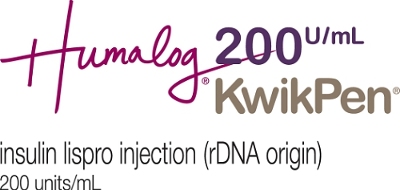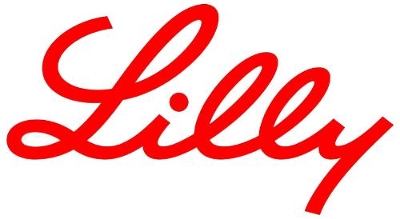Marks approval of first concentrated mealtime insulin analog in the U.S. and expands Lilly's portfolio of medicines for people with type 1 and type 2 diabetes
INDIANAPOLIS, May 27, 2015 /PRNewswire/ -- The U.S. Food and Drug Administration (FDA) has approved Humalog® 200 units/mL KwikPen® (insulin lispro 200 units/mL; U-200), a pre-filled pen containing a concentrated formulation of Lilly's rapid-acting insulin Humalog® (insulin lispro 100 units/mL) to improve glycemic control in people with type 1 and type 2 diabetes, Eli Lilly and Company (NYSE: LLY) announced today. Humalog U-200 KwikPen marks the first FDA approval of a concentrated mealtime insulin analog.
Humalog U-200 KwikPen holds twice as many units of insulin (600 units vs. 300 units) as the U-100 formulation in the same three-milliliter cartridge. This offers patients a pen that lasts longer between pen changes, allowing for fewer changes every month.* Humalog U-200 KwikPen delivers the same dose in half the volume of Humalog U-100 KwikPen with no dose conversions required, and can be dialed in one-unit increments to a maximum of 60 units per injection.
"Diabetes is a progressive disease that often requires increased doses of insulin over time to better control a patient's blood sugar levels," said David Kendall, M.D., vice president, Medical Affairs, Lilly Diabetes. "Humalog U-200 KwikPen represents a new option for people with diabetes. Fewer pen changes per month may help people who require higher daily doses of mealtime insulin better fit their treatment in their daily lives."
Approval was based on a demonstration of the bioequivalence of Humalog 200 units/mL relative to Humalog 100 units/mL in a pharmacokinetic/pharmacodynamic study. The most common side effect of Humalog is hypoglycemia (low blood sugar) that may be severe and cause unconsciousness, seizures and death. See the Important Safety Information at the end of this press release, Prescribing Information, and Patient Information.
"We are proud to advance our commitment to supporting people with diabetes," said Mike Mason, vice president, U.S., Lilly Diabetes. "Humalog U-200 KwikPen is an example of our work to improve the patient experience. This product is the newest addition to Lilly's growing portfolio of diabetes treatment options for people in the United States."
The U.S. approval follows the approval of Humalog 200 units/ml KwikPen in the European Union on October 3, 2014.
*Once opened, Humalog prefilled pens should be thrown away after 28 days, even if insulin remains.
Indication: HUMALOG is a rapid acting human insulin analog indicated to improve glycemic control in adults and children with diabetes mellitus.
Important Safety Information for Humalog 100 units/mL and Humalog 200 units/mL KwikPen
CONTRAINDICATIONS
- Humalog is contraindicated during episodes of hypoglycemia and in patients who are hypersensitive to Humalog or any of its excipients.
WARNINGS AND PRECAUTIONS
- Never Share a Humalog KwikPen, Cartridge, Reusable Pen Compatible with Lilly 3 mL Cartridges, or Syringe Between Patients: Humalog KwikPens, cartridges, and reusable pens compatible with Lilly 3 mL cartridges must never be shared between patients, even if the needle is changed. Patients using Humalog vials must never share needles or syringes with another person. Sharing poses a risk for transmission of blood-borne pathogens.
- Changes in Insulin Regimen: Changes may affect glycemic control and predispose to hypoglycemia or hyperglycemia. These changes should be made cautiously under close medical supervision and the frequency of blood glucose monitoring should be increased.
- Hypoglycemia: Severe hypoglycemia may be life threatening and can cause seizures or death. Hypoglycemia is the most common adverse reaction of Humalog. The patient's ability to concentrate and react may be impaired as a result of hypoglycemia. Hypoglycemia can happen suddenly and symptoms may vary for each person and may change over time. Early warning symptoms of hypoglycemia may be different or less pronounced under conditions such as long-standing diabetes, diabetic nerve disease, use of medications such as beta-blockers, or in patients who experience recurrent hypoglycemia. These situations may result in severe hypoglycemia and possibly loss of consciousness prior to the patient's awareness of hypoglycemia.
Timing of hypoglycemia usually reflects the time-action profile of administered insulins which may vary in different individuals or at different times in the same individual. Other factors such as changes in food intake, injection site, exercise, and concomitant medications may increase the risk of hypoglycemia.
Educate patients to recognize and manage hypoglycemia. In patients at higher risk for hypoglycemia and patients with reduced symptomatic awareness, increased frequency of blood glucose monitoring is recommended. Patients with renal or hepatic impairment may be at higher risk of hypoglycemia. - Hypoglycemia Due to Medication Errors: Instruct patients to always check the insulin label before each injection to avoid medication errors.
Humalog U-200 should not be transferred from the Humalog KwikPen to a syringe as overdose and severe hypoglycemia can occur. - Hypersensitivity Reactions: Severe, life-threatening, generalized allergy, including anaphylaxis, can occur with Humalog. If hypersensitivity reactions occur, discontinue Humalog and treat per standard of care until signs and symptoms resolve.
- Hypokalemia: Hypokalemia may be life threatening. Insulins, including Humalog, cause a shift in potassium from the extracellular to intracellular space possibly leading to hypokalemia, which, if untreated, may result in respiratory paralysis, ventricular arrhythmia, and death. Monitor potassium levels in patients at risk for hypokalemia (eg, patients using potassium-lowering medications or medications sensitive to serum potassium concentrations).
- Fluid Retention and Heart Failure with Concomitant Use of PPAR-gamma Agonists: Thiazolidinediones (TZDs), which are PPAR-gamma agonists, can cause dose-related fluid retention, particularly when used in combination with insulin, including Humalog. This may lead to or exacerbate heart failure. Observe patients for signs and symptoms of heart failure and consider discontinuation or dose reduction of the PPAR-gamma agonist.
- Hyperglycemia and Ketoacidosis Due to Insulin Pump Device Malfunction: Malfunction of the insulin pump device, infusion set, or insulin degradation can rapidly lead to hyperglycemia and ketoacidosis. Patients using subcutaneous insulin infusion pumps must be trained to administer insulin by injection and have alternate insulin therapy available in case of pump failure.
DRUG INTERACTIONS: Some medications may alter glucose metabolism, insulin requirements, and the risk for hypoglycemia or hyperglycemia. Signs of hypoglycemia may be reduced or absent in patients taking anti-adrenergic drugs. Particularly close monitoring may be required.
ADVERSE REACTIONS: Adverse reactions associated with Humalog include hypoglycemia, hypokalemia, allergic reactions, injection-site reactions, lipodystrophy, pruritus, rash, weight gain, and peripheral edema.
USE IN SPECIFIC POPULATIONS: Humalog has not been studied in children with type 1 diabetes less than 3 years of age or in children with type 2 diabetes.
DOSAGE AND ADMINISTRATION
- Humalog should be given within 15 minutes before or immediately after a meal.
- Humalog U‑100 can be administered intravenously under medical supervision with close monitoring of blood glucose and potassium levels to avoid hypoglycemia and hypokalemia. Do NOT administer Humalog U-200 intravenously.
- Humalog U-100 for subcutaneous injection should only be mixed with NPH insulin. If Humalog U-100 is mixed with NPH insulin, Humalog should be drawn into the syringe first. Injection should occur immediately after mixing. Do NOT mix Humalog U-200 in a syringe with any other insulin.
- Humalog U-100 should not be diluted or mixed when used in an external insulin pump. Change Humalog U-100 in the reservoir at least every 7 days. Change the infusion set and insertion site at least every 3 days. Do NOT use Humalog U-200 in a subcutaneous insulin infusion pump.
- Do NOT perform dose conversion when using either the Humalog U-100 or Humalog U-200 KwikPens. The dose window shows the number of insulin units to be delivered and no conversion is needed.
Please click to access Full Prescribing Information and Patient Information.
Please see Instructions for Use included with the pen.
HI U200 HCP ISI 26MAY2015
About Diabetes
Approximately 29 million Americans have type 1 and type 2 diabetes.1 Type 2 diabetes is the most common type, accounting for an estimated 90 to 95 percent of all diabetes cases.1 Diabetes is a chronic disease that occurs when the body either does not properly produce, or use, the hormone insulin.1
About Lilly Diabetes
Lilly has been a global leader in diabetes care since 1923, when we introduced the world's first commercial insulin. Today we are building upon this heritage by working to meet the diverse needs of people with diabetes and those who care for them. Through research and collaboration, a broad and growing product portfolio and a continued determination to provide real solutions—from medicines to support programs and more—we strive to make life better for all those affected by diabetes around the world. For more information, visit www.lillydiabetes.com and follow @LillyDiabetes on Twitter.
About Eli Lilly and Company
Lilly is a global healthcare leader that unites caring with discovery to make life better for people around the world. We were founded more than a century ago by a man committed to creating high-quality medicines that meet real needs, and today we remain true to that mission in all our work. Across the globe, Lilly employees work to discover and bring life-changing medicines to those who need them, improve the understanding and management of disease, and give back to communities through philanthropy and volunteerism. To learn more about Lilly, please visit us at www.lilly.com and newsroom.lilly.com/social-channels.
This press release contains forward-looking statements about Humalog 200 units/mL KwikPen for use in the treatment of diabetes. It reflects Lilly's current beliefs; however, as with any such undertaking, there are substantial risks and uncertainties in the process of drug development and commercialization. There is no guarantee that future study results and patient experience will be consistent with study findings to date or that Humalog 200 units/mL KwikPen will be commercially successful. For further discussion of these and other risks and uncertainties, please see Lilly's latest Forms 10-Q and 10-K filed with the U.S. Securities and Exchange Commission. Lilly undertakes no duty to update forward-looking statements.
|
1. Centers for Disease Control and Prevention. National Diabetes Statistics Report: Estimates of Diabetes and Its Burden in the United States, 2014. Atlanta, GA: U.S. Department of Health and Human Services; 2014. |
LD96350 05/2015 ©Lilly USA, LLC 2015. All rights reserved.
P-LLY
Refer to: +1 (317) 627-4056; [email protected]; Julie Williams


Logo - http://photos.prnewswire.com/prnh/20150526/218405LOGO
Logo - http://photos.prnewswire.com/prnh/20031219/LLYLOGO
To view the original version on PR Newswire, visit:http://www.prnewswire.com/news-releases/us-food-and-drug-administration-approves-humalog-200-unitsml-kwikpen-300089341.html
SOURCE Eli Lilly and Company